





Agaves are wonderful garden plants and make excellent potted plants as well. Since they do so well in pots, they can be grown in any state in the U.S. indoors in winter and outdoors in the summer, weather permitting, or outdoors year round in those areas where little or no frost is encountered.
(Editor's Note: This article was originally published on October 19, 2007. Your comments are welcome, but please be aware that authors of previously published artiles may not be able to respond to your questions.)
These primarily Mexican plants come in many different sizes and colors, though the general look is an elegant symmetrical rosette made up of spiny, succulent, often stiff and well-armed leaves with little or no stem. Some plants get large, up to 20 feet in diameter, while others may barely exceed a few inches. Some are soft and spineless- quite 'user-friendly' while others are indeed dangerous plants to be too near, armed with sharp, stiff hooks and dagger-like terminal leaf spines. Most are fairly easy to grow and take little care once established. And, since many species offset freely, there are dozens of species readily available at local nurseries or online for reasonable prices. This is one of the faster-growing succulents, so starting off with a small seedling does not mean you will have to grow old in order to see your plants mature to adult size. Agaves also come in a variety of colors and are excellent 'decorator' plants for those who need a hardy plant with a predictable shape but needs a plant to match a certain color scheme. Needing little water and little fertililizer, agaves are plants that require little attention yet reward the grower with a unique southwest look and artful presence.
For pot culture it is best to use a well-draining mix in a relatively shallow pot, though most agaves will do well in deep pots, too... just a waste of soil. In general, these are not easy plants to overwater as are many other succulents, but some exceptions exist. And they are not plants that are easy to underwater either, though no agave can exist forever without at least some water. Watering thoroughly once a week in the summers (more often in plant is in full sun or and unglazed clay pot, or if you live in a hot, dry climate) is usually fine, and less often, to hardly at all, in winters. I tend to water more often than I probably should since my potted agaves are all mixed in with lots of other plants that need more frequent watering, and, so far, I have not had any problems.
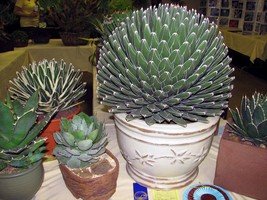
Here are some potted agaves in a succulent show in California
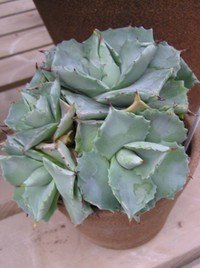
This is Agave 'Shoji Raijin', a bizarre form of Agave potatorum, one of the smaller and more variable species of agave and an excellent smaller plant for pot culture
After several years it is recommended to change the soil. This is good time to see what's going on with the roots, as some agave roots will completely fill the pot and suckers may be crowding the mother plant. Either the plant can be moved up a pot size if this is the case, or you can remove the suckers and most of the roots and repot it back in the same pot. Most agaves tolerate a good deal of root abuse and reroot quickly. If there is severe root damage from the repotting procedure it is probably best not to water you agave for a week or so, and keep it out of full, hot sun until then. Don't repot in the dead of winter as that may lead to root rot. Repotting is also a good time to remove old, dead leaves, weeds (see the photo below) and any parasites you might find near the leaf bases or on the roots.
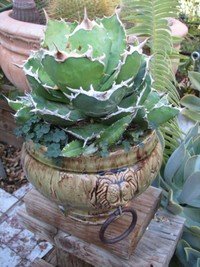
This Agave 'Felipe Otero' (a relative of Agave titanota, but not the same thing, probably) has been in this pot for years, and its suckers are dying to get out and grow larger. Also notice the weeds (Oxalis). The only way to remove these suckers, and weeds for that matter, is to unpot the plant, remove all the soil (weed seeds), cut off the suckers (or pull them off) and repot it... back in the same pot or a slightly larger one
Many agaves make excellent show plants as one can grow a relatively large, old plant in a pretty small pot. They are natural works of art and grow into very predictable sizes and shapes. Sometimes suckering is a desirable trait in a show plant, but most of the time it is not, so repotting show plants can be a routine chore.
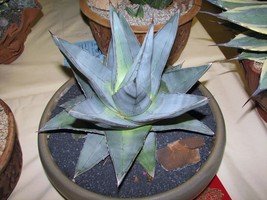
This Agave pumila is an example of a very sought-after show plant. This species is very slow growing and very few growers would put this in the ground, even if they lived in the right climate- too small a plant and way too valuable. A plant this size (about 6 inches in diameter) is probably many decades old and worth a lot of money.
Garden culture is even easier than pot culture - in most suitable climates one need only plant an agave, and other than removing unwanted suckers (which can be a real chore in some species) and dead leaves, most garden plants need little or no care at all. Before one puts an agave in the garden one should do a little research about that species to make sure its suckering habits are not going to be too troublesome in the future. This can sometimes be a problem, however, as many 'solitary species' one learns about in the literature end up being suckering plants in the yard. This is because there is a natural variety of all plants in nature, and the tendency to produce offsets probably exists in most agaves whether they normally do or not. Unfortuantely it is these few rare suckering oddballs that are collected in nature by those looking to propogate a new, rare or particularly sought after species. Hauling back a large solitary plant is not only dangerous and difficult, but usually illegal. And waiting for seed to become available can take many years, and seed is less reliably apt to be grown up into a healthy plant. So most agave collectors collect the the suckers off the perhaps rare suckering individuals of a normally non-suckering species... and it is those plants that end up in cultivation and spread from nursery to nursery all over the county. Before you know it eveyone has the same clones of these 'solitary' agaves in their gardens and all are suckering like crazy. It can be very frustrating. Some nurseries are now specializing in tissue culture and seed-grown plants of the real solitary species so they are, or will, be available in the near future (at an increase cost I am sure).
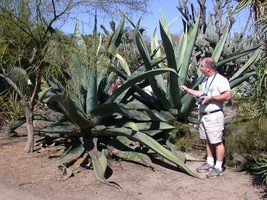
This is Agave mapisaga var. lisa and is one of the larger agave species grown in cultivation. It can have a diameter of up to 15 feet or more and is obviously far too large to ever be grown in a pot. Thankfully it is a fairly 'user-friendly' plant having no marginal teeth... just a sharp 2-inch dagger at the end of its long, rubbery leaves
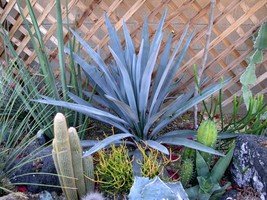
Agave tequiliana is a great garden plant and this Weber Blue form makes an outstanding constrast when planted among greener plants
If you are a flower lover this may not be your plant, as most agaves flower only once and this is usually after many years, if not decades of growth. This is typically a monocarpic genus, meaning flowering signifies the end of the plant's life. For true suckering species this is not the end of the life cycle obviously, but it sill means one will have to rid the garden or pot of the carcass once flowering is over. Most agave flowers are quite impressive and flowering is a spectacular occurence... but a sad omen of what's to come. But if you want to make more of these plants, these flowers usually produce thousands of seeds, and some species even make bulbils (small plantlets that form on the flower stalks after seed forms). Bulbils, like suckers, are pretty easy and straight forward in terms of getting them to root. Some species do not die after flowering but these are rare or not some of the more ornamental species in cultivation.
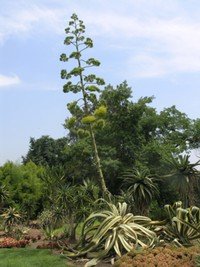
This shot of Agave americana 'Variegata' gives some idea of the massive size of some agave flowers- this one is about 25 feet or more tall
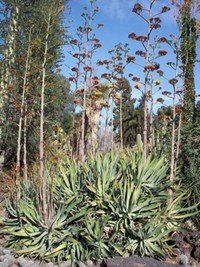
A colony of Agave capensis showing a large flowering en masse- a spectacular sight, but soon there will be a lot of dead plants to remove
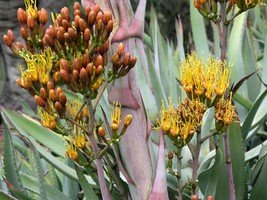
This is a close up of Agave capensis in flower
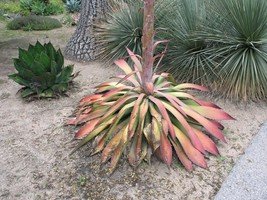
Agave bovicornuta dying after being in flower for a few weeks
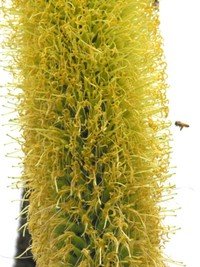
This is a close up a Agave ocahui, a species with a tall columnar flower stalk
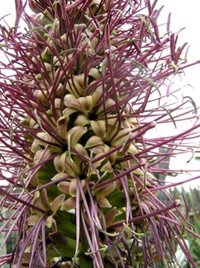
and this is Agave celsii, another species with particularly attractive flowers on a tall, columnar flower stalk (inflorescence)
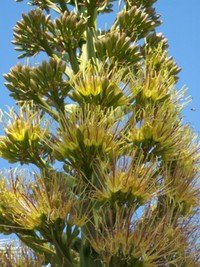
This Agave shawii hybrid flower shows the more typical flower shape and color of most agave flowers
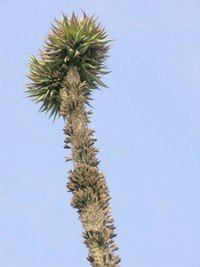
These are bulbils forming on a the top of an Agave horrida flower spike- each of those is a little tiny plantlet
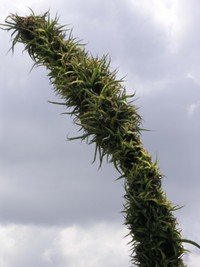
This older flower spike of Agave vilmoreana (Octopus Agave) is so covered with bulbils that it's starting to bend with the weight of them all
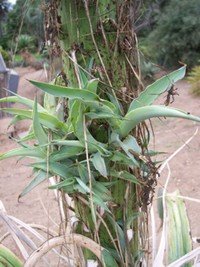
Here is a close up of some of the Agave vilmoreana bulbils
Though nearly so, agaves are not totally problem-free plants. They do need, in general, a tremendous amount of light so may not do well as year-round house plants. Plants grown in too little light become etiolated (stretched) and weak, prone to injury as well as parasites and fungus. Too much light, when unaccustomed to it, can cause some to develop sun burn, but rarely is this a serious problem - more of a blemish or loss of a leaf or two. Too much water can rot some species, with the pale blue desert-loving varieties being the most susceptible. These plants, particularly if watered from overhead, and not given sufficient sunlight or heat to dry out, will often be attacked by mealy bug or scale, or just rot and collapse.
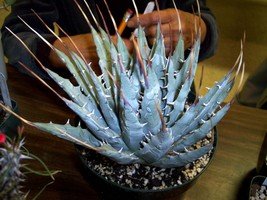
A close up here of Agave colorata showing scale living under the newly forming leaves in the center (recently opened leaf exposing some scale). This plant is only in half day sun and gets more water on its crown than it should

Agave utahensis is a wonderful pot plant, but in the garden one must be cautious about growing it in a low light situation, or in one where it gets a lot of watering from overhead. This plant is particularly drought tolerant, and tends to rot when given water frequently. This plant was lost a year after this photo from just that problem.
Some agaves sucker so vigorously that they quickly outgrow their pots or places in the garden. Potted plants are extremely tolerant of being crammed in what seems to be too-small pots for a very long time, but eventually these will need to be unpotted and have the suckers removed. Removing suckers in garden plants can hazardous if right under the parent plant. But suckers can also be a large garden nuisance (aka weed), particularly in those species that can sucker yards and yards from the parent plant. Planting these in the wrong place can then lead to having to dig up suckers and their long, rope-like roots from the garden every 6 months or so (this can mean one will have to dig up other garden plats as well in the process).
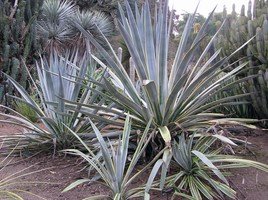
These Agave angustifolia are fairly common outdoor landscaping plants in southern California, but are probably one of the worst weed-agaves there are, producing suckers that emerge as small plants up to 15 feet feet from the main plant, and are nearly impossible to eradicate once established

This Agave tequiliana (a vareigated one) is a great garden plant, but removing its suckers is hazardous thanks to its sharp, saw-like leaves and brittle marginal spines that break off easily and imbed in your skin. This species is one of the primary sources of tequila (hence the name)
There are far too many species of agave to cover in this introductory article to do the genus any justice, but I will discuss briefly a few of the more common ones encountered in cultivation.
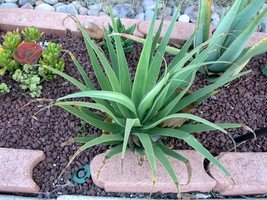
Agave bracteosa, one of the most 'user-friendly' agaves, having no spines are teeth at all- looks more like an aloe than an agave to some
Most people probably think of a large bluish plant when they think of an agave, as the most commonly grown agave throughout the lower US is Agave americana. This is a large, spiny, aggressively suckering plant, growing up to 5 feet tall with suckers growing either at its base or up to 15 feet away. In the southwest it is a common highway/freeway decorative plant, and it is often used in private gardens as a vicious and effective border plant. Some find it a beautiful plant with its pale, powdery blue leaves (yellow or white striped versions are also common) and striking jet-black terminal spine and sharp, hooked, marginal teeth. But many others find it a disagreeable plant, large, messy and aggressively invasive, dangerous to prune or weed around and impossible to get rid of in a crowded and established garden. Though there are many large, obnoxious, suckering, invasive agaves, this is at one end of the extreme and one should not judge all agaves based on their experiences with this one.
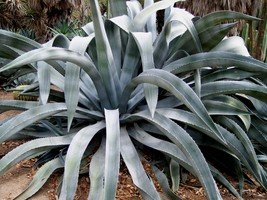
This is an idea shot of this attractive plant, but more often it looks like this
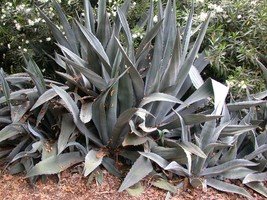
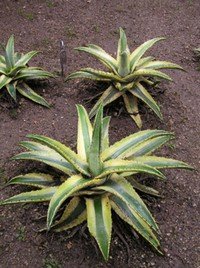
This is a variegated form of the same plant- still an agressive suckerer, but some forms are much less so.
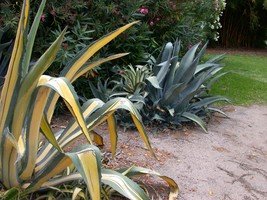
Shot of all three common forms of Agave americana- the regular blue form, the variegated form, and in the background,a white form of Agave americana 'Mediopicta', a median-striped, smaller form- probably one of the best for landscaping purposes

This is a monstrose variegated form that never gets large and hardly ever suckers. Sadly it is also quite rare
Another commonly grown and much 'safer' plant is Agave attenuata. This agave is one of the few with no sharp spines at all, and soft, rubbery, powdery leaves. It comes in a soft mint green (most common color) but rarer, exciting varities of deep turquoise blue or pale to bright yellow striped exist (more costly of course). This agave is also unique in developing a fairly long/tall stem, up to 8 feet (usually falls over before it gets this tall, and then grows along the ground). The beautiful rosettes of arching, smooth leaves can grow up to 4 feet in diameter in older plants. This is one of the most popular 'designer' plants in the southwest, used for upscale landscaping, as it makes a marvelous centerpiece as well as a compliment to many other plants in both a desert or even a tropical setting. It tolerates a lot of water, or little water, lots of sun, or mostly shade. The only thing it doesn't tolerate is frost- one of the most cold sensitive species of agave there are. But like most other agaves, is an excellent pot plant and can be moved indoors or under a patio if frost is coming.
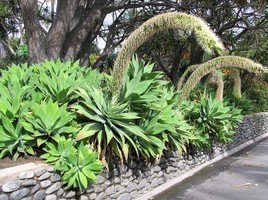
Here is a famous grove of this agave at the Huntington Botanical Gardens near Pasadena, California. Notice the typical arching flowers and wonderful, soft, light green leaves
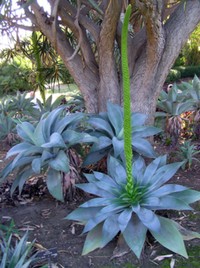
This much rarer but fantastically colored form has been labeled as Agave attenuata 'Nova' blue. It is distinguished by the pale turquoise leaf color and it has flowers that do not droop, but grow straight up in the air. These also are at the Huntington.
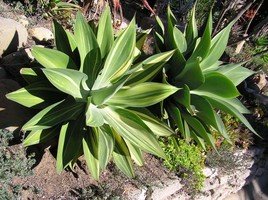
Even more rare (and costly) is this variegated form.
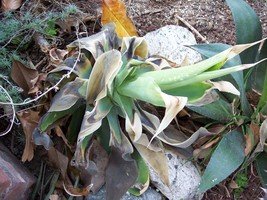
This sad-looking plant is an Agave attenuata after a freeze. As bad as it looks, most recover completely as long as the freeze doesn't last more than 12 hours, or temperatures don't get below 24F for too long. Recovery usually takes a good year.
Agave parryi is another commonly grown plant in the southwest and an extremely variable one, with lots of forms and synonyms. It is a very stiff-leaved, dangerously spiny pale blue plant with strikinig jet-black large marginal teeth and termimal spine. It is a fairly slow and extremely elegant plant, making a wonderful potted specimen as well as a fairly care-free garden plant. It is a prolific suckerer (though not all forms sucker), but is slow growing and suckers are generally easy to manage and take care of, even if not discovered immediately. Agave parryi var. truncata is one of the more beautiful forms of this plant developing numerous overlapping rounded leaves that from a distance resemble reptile scales or a giant artichoke- an highly ornamental look. Agave patonii variegated is actually a form of Agave parryi and is a small, flattened plant excellently suited for pot culture. It is extremely slow growing and moderately large specimens are quite costly.
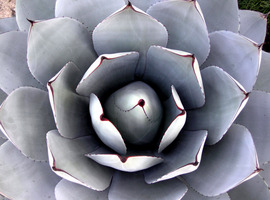
This is a top view of Agave parryi var. truncata, showing the wonderful blue color, spination and fantastic symmetry.
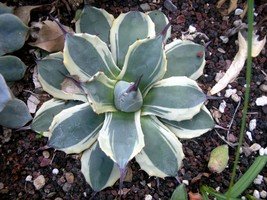
This is Agave patonii, only about 4 inches in diameter yet 6-7 years old.
One of the most recognized and sought after agaves is Agave victoriae-reginae. This is an amazing plant eventually forming a perfect sphere of dark green, arching, thick, stiff leaves, strikingly marked with chalk-like white lines. These are very slow growing agaves, but relatively simple in their requirements. An old, undamaged specimen can be worth a lot of money and, if potted, can become an easy show winner as well. Though slow, it is a relatively long-lived plant, so one needn't worry about this dying too soon of old age, especially if grown from a small seedling. These plants also come in several highly ornamental varieties, including interesting variegated forms, small suckering ones and some with accentuated markings or larger than normal leaves. Agave ferdinand-regis is a form of Agave victoriae-reginae with larger leaves and a more rosette.
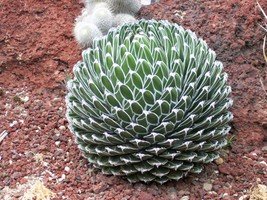
This is a very old specimen in southern California (flowered one year after this photo taken)
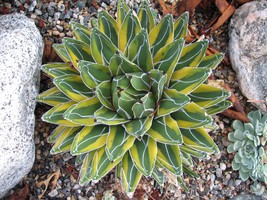
Top view of a variegated form in part sun (sometimes full sun will bleach or fade the variegated color, so for more vibrant looking plants, grow this is slight shade)
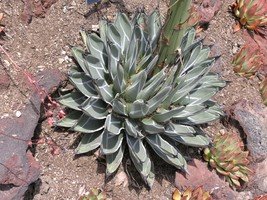
This is Agave ferdinand-regis flowering outdoors in southern California
Copyright © www.100flowers.win Botanic Garden All Rights Reserved